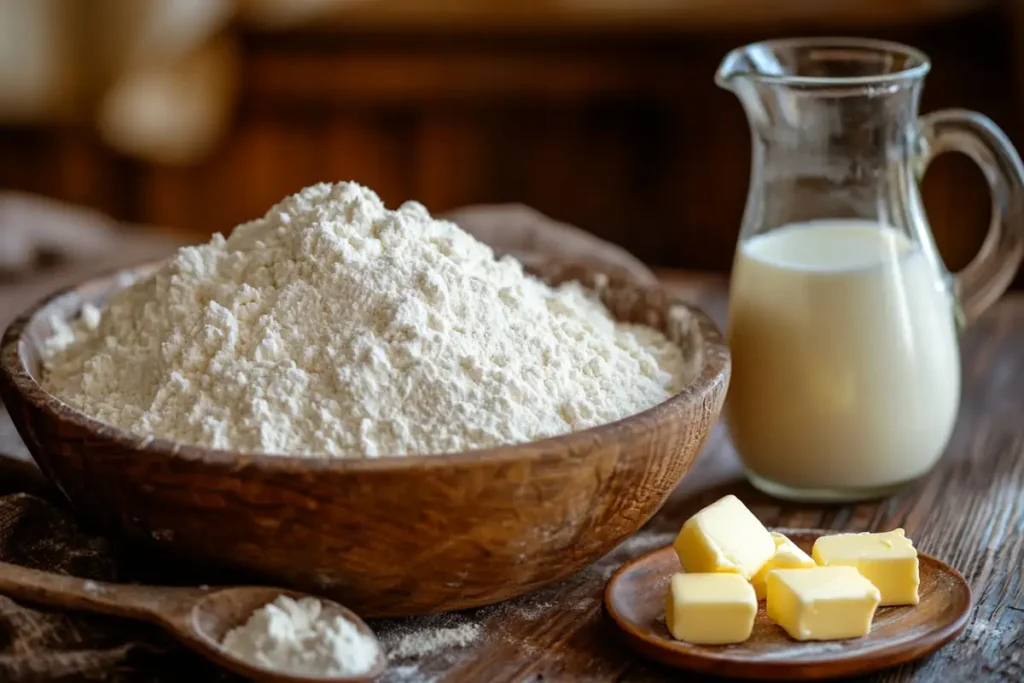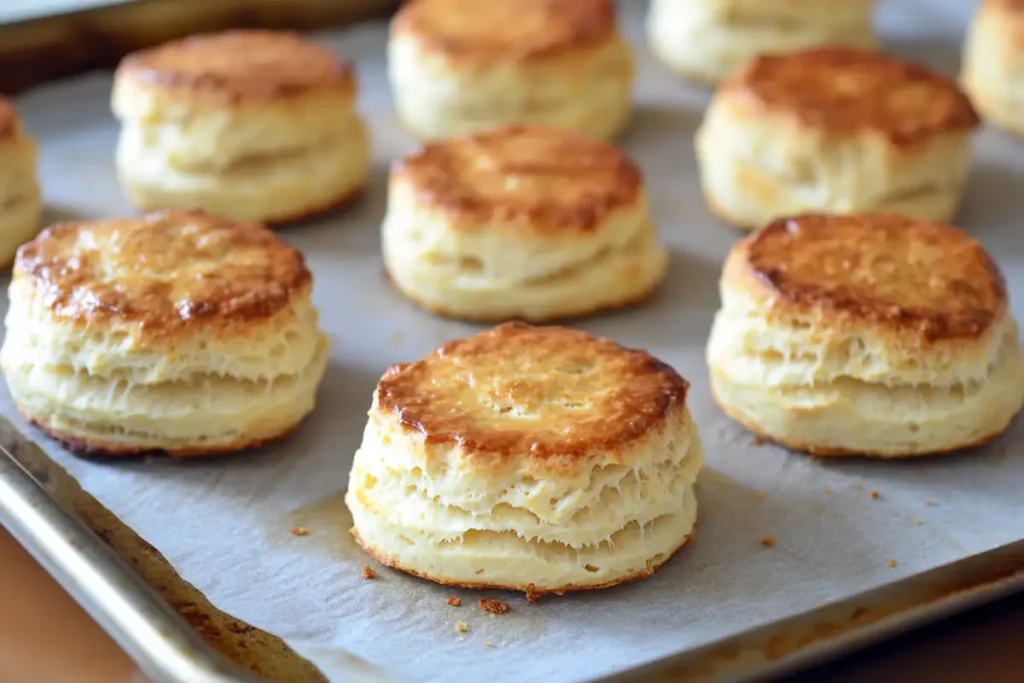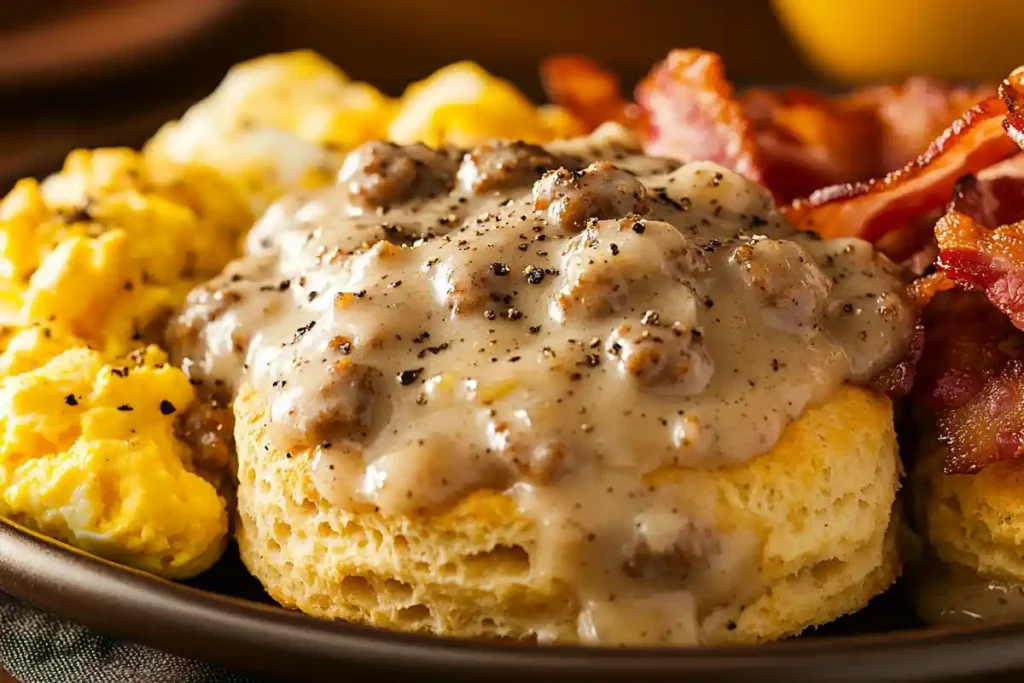Nothing beats the warm, flaky goodness of a classic American breakfast biscuit. Whether served with gravy, turned into a breakfast sandwich, or enjoyed with a drizzle of honey, these buttery delights are a staple in Southern cuisine. But what exactly makes a breakfast biscuit unique?
In this guide, we’ll explore everything about American breakfast biscuits, from their history and ingredients to step-by-step preparation techniques. Plus, we’ll cover delicious variations and serving ideas to elevate your next breakfast.
Understanding the American Breakfast Biscuit
What Is an American Breakfast Biscuit?
An American breakfast biscuit is a soft, fluffy, and slightly crispy bread roll made from flour, butter, milk, and a leavening agent like baking powder. Unlike crackers or European biscuits (which are cookies), these savory pastries are typically served as a side dish for breakfast.
Biscuits have a light and airy texture, achieved by folding and kneading the dough to create delicate layers. Their rich, buttery flavor makes them a versatile component of Southern breakfasts and comfort meals.
A Brief History of American Breakfast Biscuits
Biscuits trace their roots back to pre-Civil War America, when home bakers relied on simple, affordable ingredients to make quick bread. Unlike yeast-based bread, biscuits required no rising time, making them a convenient alternative.
Origins in the Southern United States
The American South quickly embraced biscuits due to the region’s agricultural resources. Flour, butter, and buttermilk were readily available, and these ingredients led to the creation of the Southern-style buttermilk biscuit. The technique of “lamination” (folding dough to create layers) gave biscuits their iconic flakiness.
Evolution Over the Years
Over time, biscuits became a household favorite, with restaurants and diners serving them alongside gravy, eggs, and meats. Today, they remain a signature item in Southern cuisine, often featured in popular breakfast menus across the United States.
Ingredients and Preparation
Biscuits may seem simple, but achieving the perfect texture requires the right ingredients and techniques. Whether you want fluffy, flaky, or buttery biscuits, understanding the role of each ingredient is key.
Key Ingredients in American Breakfast Biscuits
Flour: The Foundation of Flaky Biscuits
The choice of flour significantly impacts the texture and taste of biscuits.
- All-purpose flour: The most common choice, offering a balance between softness and structure.
- Self-rising flour: Contains pre-mixed baking powder and salt, ideal for quicker biscuit preparation.
- Southern-style soft wheat flour: Lower in protein, making biscuits extra tender and delicate.
Leavening Agents: The Secret to a Light and Airy Texture
Biscuits rely on chemical leaveners instead of yeast to create their signature rise.
- Baking powder: Provides an even, controlled rise, ensuring biscuits are fluffy but not dense.
- Baking soda: Used when buttermilk or an acidic ingredient is present to create a lighter structure.
Fats: The Key to a Buttery, Flaky Texture
The type of fat determines how rich and tender your biscuits will be.
- Butter: Enhances flavor while creating flaky layers when cut into the flour.
- Shortening: Results in a softer and more cake-like texture.
- Lard: A traditional choice that adds a rich, savory taste and flakiness.
Liquid Ingredients: The Moisture Factor
Biscuits need just enough liquid to bind the ingredients without making the dough too sticky.
- Buttermilk: A classic ingredient that provides a slight tang while activating baking soda for extra rise.
- Whole milk: A good alternative, offering a mild sweetness and softer texture.
- Heavy cream: Produces rich, tender biscuits with a buttery mouthfeel.

Step-by-Step Preparation Guide
Making homemade American breakfast biscuits requires proper technique. Following are the steps to achieve the best results!
1. Mixing the Dough: Combining Dry and Wet Ingredients
- In a large mixing bowl, whisk together the flour, baking powder, and salt.
- Cut in cold butter using a pastry cutter or fingertips until the mixture resembles coarse crumbs.
- Slowly add buttermilk or milk, stirring until the dough just comes together. Avoid overmixing!
2. Kneading and Folding: Creating Flaky Layers
- Turn the dough onto a lightly floured surface and gently knead 3–4 times.
- Using a rolling pin, roll the dough into a ¾-inch thick rectangle.
- Fold the dough over itself, rotate, and repeat 2–3 times for extra layers.
3. Cutting and Shaping: Getting the Perfect Biscuit Shape
- Use a biscuit cutter or a round glass to cut out biscuits.
- Press straight down without twisting to maintain a clean, even rise.
- Gather scraps, reshape, and cut more biscuits without overworking the dough.
4. Baking Process: Achieving Golden-Brown Perfection
- Preheat the oven to 425°F (220°C) and place biscuits on a parchment-lined baking sheet.
- For extra crispiness, brush the tops with melted butter before baking.
- Bake for 12–15 minutes until the tops are golden brown and the layers are visible.

Variations and Serving Suggestions
The beauty of an American breakfast biscuit is its versatility. Whether you prefer them savory, cheesy, or infused with herbs, there’s a variation to satisfy every taste. In addition, knowing how to serve biscuits can take your breakfast experience to the next level!
Popular Variations of American Breakfast Biscuits
Buttermilk Biscuits: The Classic Southern Favorite
Buttermilk biscuits are the gold standard of American breakfast biscuits. Their tangy flavor and ultra-fluffy texture set them apart. Buttermilk reacts with baking soda, helping create the perfect rise.
Cheese Biscuits: A Savory Twist
Adding cheddar, parmesan, or gouda to biscuit dough creates an irresistibly cheesy, savory bite. These biscuits pair beautifully with soups, stews, and breakfast platters.
Best cheeses to use: Sharp cheddar for a bold taste, or parmesan for a nutty, salty kick.
Herb-Infused Biscuits: Aromatic and Flavorful
Fresh herbs like rosemary, thyme, or chives add a gourmet touch to homemade biscuits. These biscuits work well with gravy, roasted meats, or even as a side for brunch.
Pro tip: Finely chop herbs and mix them evenly into the dry ingredients before adding the fat.
Serving Suggestions: How to Enjoy Biscuits Like a Pro
Classic Pairings: Biscuits with Gravy
The ultimate Southern breakfast? Biscuits smothered in rich, creamy sausage gravy! This combo is a hearty, comforting meal that has been a staple for generations.

Breakfast Biscuit Sandwiches: A Hearty Start to the Day
Biscuits make the perfect base for a delicious breakfast sandwich. Layer them with eggs, cheese, and a protein of choice for a filling meal.
Great add-ons: Scrambled eggs, melted cheese, and a veggie patty for a vegetarian twist.
Sweet Toppings: Biscuits as a Dessert
Biscuits aren’t just for savory dishes they make a fantastic sweet treat, too! Try them with:
- Honey for a natural, floral sweetness
- Fruit preserves for a burst of fruity flavor
- Whipped cream and fresh berries for a strawberry shortcake-inspired delight
Part 4: Cultural Significance and Regional Differences
The American breakfast biscuit is more than just a delicious treat it’s a symbol of Southern hospitality, comfort food, and cultural heritage. While its roots lie in the Southern United States, regional variations have emerged, each with its own unique spin.
The Cultural Importance of Biscuits in American Cuisine
The Role of Biscuits in Southern Traditions
In the Southern United States, biscuits have long been a staple of home-cooked meals. They represent:
- Hospitality: In the South, offering warm biscuits is a sign of welcome and generosity.
- Family traditions: Many Southern families pass down biscuit recipes through generations.
- Comfort food: Biscuits are enjoyed with gravy, butter, or jam, making them a go-to dish for breakfast or brunch.
Biscuits in Popular Culture
Biscuits have made their mark on American pop culture, appearing in:
- TV shows and movies that highlight Southern cuisine.
- Cookbooks and food blogs that celebrate traditional baking techniques.
- Fast-food chains that serve biscuit-based breakfast sandwiches.
Regional Variations Across the United States
While the Southern buttermilk biscuit remains the gold standard, different regions have developed their own takes on this classic.
Southern-Style Biscuits: The Gold Standard
Traditional Southern biscuits are known for their:
- Flaky layers created by carefully folding and rolling the dough.
- Rich, buttery taste from high-fat content.
- Tall, fluffy texture, thanks to self-rising flour or baking powder.
Northern and Western Adaptations
Outside the South, biscuit variations take on new flavors and textures:
Midwestern cheese biscuits: Often loaded with cheddar or parmesan.
West Coast whole-wheat biscuits: Made with healthier flours for a denser, nuttier flavor.
Herb-infused biscuits in New England: Often paired with seafood dishes.
Each region brings its own twist, making the American breakfast biscuit a nationwide favorite with endless variations.
FAQs About American Breakfast Biscuits
Biscuits may seem simple, but people still have plenty of questions about them! From baking tips to storage methods, here are some of the most commonly asked questions about American breakfast biscuits.
What Is the Difference Between a Biscuit and a Scone?
Although biscuits and scones look similar, they have distinct differences:
- Biscuits are lighter, flakier, and less sweet, making them perfect for savory dishes.
- Scones are denser, sweeter, and often contain mix-ins like raisins, nuts, or chocolate.
- Biscuits use butter or shortening, while scones often contain eggs and heavy cream for a richer texture.
Pro Tip: Want a flakier biscuit? Use cold butter and don’t overwork the dough!
Can I Make Biscuits Ahead of Time?
Yes! Biscuits can be prepared in advance for busy mornings.
Refrigerate raw biscuit dough for up to 2 days before baking. Freeze unbaked biscuits on a baking sheet, then store them in an airtight container for up to 3 months.
Bake straight from the freezer just add 2–3 extra minutes to the baking time!
Can I Freeze Biscuit Dough for Later Use?
Absolutely! Freezing biscuit dough saves time and ensures freshly baked biscuits anytime.
How to freeze biscuit dough:
- Cut the dough into biscuit shapes then flash-freeze on a baking sheet.
- Once frozen, transfer to an airtight bag and store for up to 3 months.
- Bake straight from frozen no need to thaw!
Pro Tip: Chill your biscuits before baking this helps the butter stay solid, leading to better flakiness!
Conclusion & Final Thoughts
The American breakfast biscuit is more than just a side dish it’s a symbol of comfort, tradition, and versatility. Whether you enjoy them flaky and buttery, smothered in gravy, or turned into a hearty breakfast sandwich, biscuits are a timeless favorite that can be made in countless ways.
Key Takeaways for the Perfect Biscuit Experience
- Choose the right ingredients—cold butter, quality flour, and buttermilk for the best texture.
- Master the technique—folding the dough and using proper baking temperatures create flaky layers.
- Experiment with flavors—from cheese-infused biscuits to herb-seasoned delights, there’s no limit to creativity.
- Store them right—whether freezing the dough or keeping leftovers fresh, proper storage ensures biscuits taste great anytime.
No matter how you serve them, homemade biscuits bring warmth and joy to the breakfast table. So, the next time you crave a hearty, Southern-style breakfast, whip up a fresh batch of American breakfast biscuits your taste buds will thank you!
